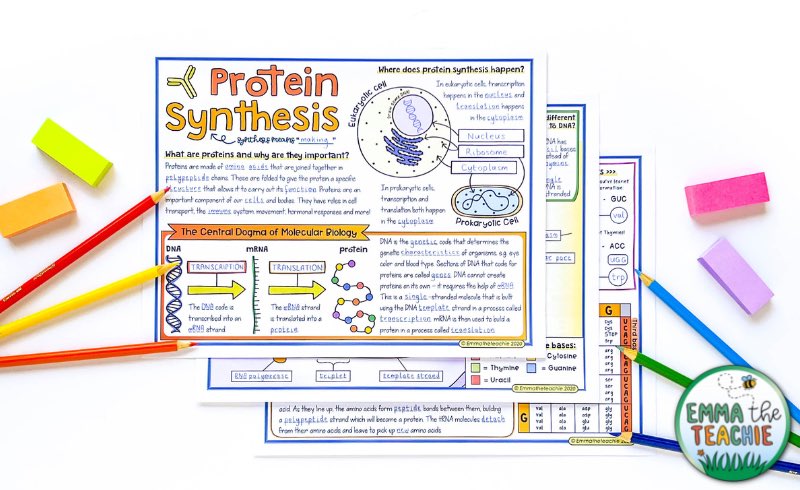
3 Ways to Finish Your Biology Course Content Quickly
Time is the one thing you can never get back, and there never seems to be enough of it. Am I right?
There are always distractions, such as pep rallies or snow days, that keep you from getting to the end of the material in a timely manner.
Before you know it, the end of the course or test date is right around the corner, and you realize that you have so much content left to cover.
Today, I want to help you explore three ways to quickly navigate the rest of the content in your biology course.

1 – Use the Jigsaw method
One of the most time-saving activities to use in the classroom is the jigsaw method.
If you’re not familiar with the jigsaw method, let’s discuss it real quick.
Jigsaw is a popular collaborative learning strategy in which students divide into small groups. In their small groups, each member is responsible for learning and teaching a different piece of information related to a common topic.
In this approach, students work together to assemble the pieces of information, share their findings with each other, and complete a project or assignment that the rest of the class can use to take notes on.
Think about it…
…if you have six groups, that means six major topics can be covered in one class period.
Amazing!
Let’s take an example. If I still needed to teach body systems and I had six groups, I would assign one body system to each group. One group would research the digestive system, another group would research the endocrine system, and so on.

Following research, each group must create an informative poster that can be viewed during a gallery walk. During this gallery walk, students have a recording sheet where they are recording the important information.
Students are held accountable because they must learn from each other rather than relying solely on the teacher for instruction.
By breaking down complex topics into manageable chunks, the jigsaw approach can also help students develop a deeper understanding of the material and build valuable teamwork and communication skills.
The jigsaw method is brilliant for covering your biology course content quickly, and students really enjoy it!
2 – Use Biology Doodle Notes
As the end of the biology course or the date of the standardized test nears, you may realize that you don’t have time for extended reviews.
This is where Doodle Notes come in handy!
Doodle Notes can help students save time, since students don’t have to write as much.
They condense the key information into just a few pages.

Students can complete Doodle Notes independently without direct instruction from you, the teacher. As a result, students can work at their own pace. And as a bonus, you now have time to help struggling students.
Or if you are really tight on time, you can complete them together as a class using a visualizer, or by projecting them on your board. This keeps everyone working together at a fast pace.
Read more about how to use Doodle Notes in my blog post.
I love Doodle Notes and have been using them forever. You can check out my Doodle Notes here.
3 – Flip your classroom
Lastly, you can save time in the classroom by switching to a flipped classroom model.
In a flipped classroom, students would watch a video lecture, or read information, and take notes at home.
Once students come back into the class, there is a brief amount of time for questions about the material. And then the rest of the class is spent doing hands-on activities, such as laboratory activities.
Now, the time in class is spent doing more advanced learning activities, which will help students understand the material better.
An example of a flipped lesson
Let’s use cellular respiration as an example.
For a flipped lesson, the students would be assigned a video. This would cover the basics of cellular respiration, including the different types of respiration and the key molecules involved. While this could be a generic video, it would provide better results if you recorded your lecture since students are used to that style of teaching.
Or you could assign a textbook reading about cellular respiration.

Once students come into the classroom on the next day, you can ask the students if they have any questions or thoughts about the videos or reading from last night.
Afterwards, students constructively work with the topic for the rest of the class. A sample lesson could look like this:
- Interactive Activity: In class, students work in small groups to complete an interactive simulation. This should allow them to explore the process of cellular respiration and its different components. Not sure where to find simulations? Check out my blog post on the Top 8 Websites for Biology Teachers for some inspiration.
- Group Discussion: After completing the simulation, students participate in a group discussion. Ask them to share their observations and insights about cellular respiration. You can put some prompt questions on the board for this.
- Application Exercise: Students complete an application exercise where they apply their understanding of cellular respiration to a real-world scenario. This could be explaining why a marathon runner needs to consume more oxygen than a sedentary person.
- Wrap-Up: provide a summary of the key concepts that students should’ve gotten out of the lesson. Address any remaining questions or concerns from students.
Well… would you look at that?! Not only did you cover one whole topic quickly, the students also collaborated and used a real-life situation as inquiry.
Now, I would say that is a pretty time-saving but also engaging lesson. (*insert winking face emoji*)
If you can get your students used to a flipped classroom, then this is a brilliant way to accelerate your biology course and get through the content quickly.
Don’t sweat it, you are in control
Feeling rushed at the end of the year is never fun, but it is definitely what you make of it.
If you remain calm, pivot your activities to fit the time, and trust your abilities, then your students will be just as engaged and learn as they would have before.
You may even find a teaching method or resource that you love and didn’t even know existed!
I hope you found this article useful.
Have a wonderful day,




